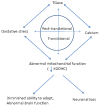Cause and consequence: mitochondrial dysfunction initiates and propagates neuronal dysfunction, neuronal death and behavioral abnormalities in age-associated neurodegenerative diseases
- PMID: 19715758
- PMCID: PMC2790547
- DOI: 10.1016/j.bbadis.2009.08.010
Cause and consequence: mitochondrial dysfunction initiates and propagates neuronal dysfunction, neuronal death and behavioral abnormalities in age-associated neurodegenerative diseases
Abstract
Age-related neurodegenerative diseases are associated with mild impairment of oxidative metabolism and accumulation of abnormal proteins. Within the cell, the mitochondria appears to be a dominant site for initiation and propagation of disease processes. Shifts in metabolism in response to mild metabolic perturbations may decrease the threshold for irreversible injury in response to ordinarily sublethal metabolic insults. Mild impairment of metabolism accrue from and lead to increased reactive oxygen species (ROS). Increased ROS change cell signaling via post-transcriptional and transcriptional changes. The cause and consequences of mild impairment of mitochondrial metabolism is one focus of this review. Many experiments in tissues from humans support the notion that oxidative modification of the alpha-ketoglutarate dehydrogenase complex (KGDHC) compromises neuronal energy metabolism and enhances ROS production in Alzheimer's Disease (AD). These data suggest that cognitive decline in AD derives from the selective tricarboxylic acid (TCA) cycle abnormalities. By contrast in Huntington's Disease (HD), a movement disorder with cognitive features distinct form AD, complex II+III abnormalities may dominate. These distinct mitochondrial abnormalities culminate in oxidative stress, energy dysfunction, and aberrant homeostasis of cytosolic calcium. Cytosolic calcium, elevations even only transiently, leads to hyperactivity of a number of enzymes. One calcium-activated enzyme with demonstrated pathophysiological import in HD and AD is transglutaminase (TGase). TGase is a crosslinking enzymes that can modulate transcription, inactivate metabolic enzymes, and cause aggregation of critical proteins. Recent data indicate that TGase can silence expression of genes involved in compensating for metabolic stress. Altogether, our results suggest that increasing KGDHC via inhibition of TGase or via a host of other strategies to be described would be effective therapeutic approaches in age-associated neurodegenerative diseases.
Figures




References
-
- Browne SE. Mitochondria and Huntington’s disease pathogenesis: insight from genetic and chemical models. Ann N Y Acad Sci. 2008;1147:358–382. - PubMed
-
- Klivenyi P, Starkov AA, Calingasan NY, Gardian G, Browne SE, Yang L, Bubber P, Gibson GE, Patel MS, Beal MF. Mice deficient in dihydrolipoamide dehydrogenase show increased vulnerability to MPTP, malonate and 3-nitropropionic acid neurotoxicity. J Neurochem. 2004;88:1352–1360. - PubMed
-
- Schapira AHV. Mitochondria in the aetiology and pathogenesis of Parkinson’s disease. The Lancet Neurology. 2008;7:97–109. - PubMed
-
- Thomas B, Beal MF. Parkinson’s disease. Hum Mol Genet. 2007;16:R183–194. - PubMed
Publication types
MeSH terms
Substances
Grants and funding
LinkOut - more resources
Full Text Sources
Medical

